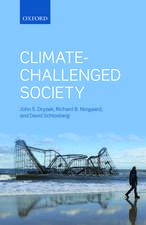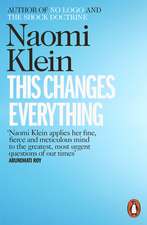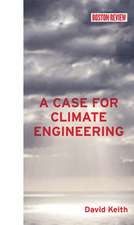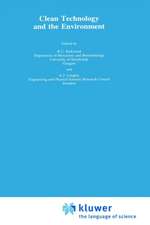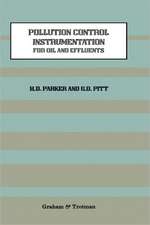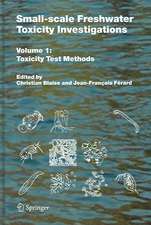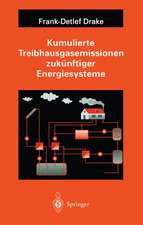The Computational Structure of Life Cycle Assessment: Eco-Efficiency in Industry and Science, cartea 11
Autor R. Heijungs, Sangwon Suhen Limba Engleză Hardback – 31 mai 2002
This book presents the first coherent treatment of the mathematical and algorithmic aspects of LCA. These computational aspects are presented in matrix form, so that a concise and elegant formulation is achieved. This form, moreover, provides a platform for further extension of analysis using perturbation theory, structural theory and economic input-output analysis.
| Toate formatele și edițiile | Preț | Express |
|---|---|---|
| Paperback (1) | 942.63 lei 6-8 săpt. | |
| SPRINGER NETHERLANDS – 10 apr 2011 | 942.63 lei 6-8 săpt. | |
| Hardback (1) | 901.53 lei 3-5 săpt. | +23.98 lei 6-12 zile |
| SPRINGER NETHERLANDS – 31 mai 2002 | 901.53 lei 3-5 săpt. | +23.98 lei 6-12 zile |
Din seria Eco-Efficiency in Industry and Science
- 18%
 Preț: 951.29 lei
Preț: 951.29 lei - 15%
 Preț: 640.24 lei
Preț: 640.24 lei - 15%
 Preț: 654.77 lei
Preț: 654.77 lei - 15%
 Preț: 648.42 lei
Preț: 648.42 lei -
 Preț: 391.61 lei
Preț: 391.61 lei - 15%
 Preț: 642.51 lei
Preț: 642.51 lei - 15%
 Preț: 643.34 lei
Preț: 643.34 lei - 18%
 Preț: 957.62 lei
Preț: 957.62 lei - 18%
 Preț: 953.35 lei
Preț: 953.35 lei - 18%
 Preț: 1238.74 lei
Preț: 1238.74 lei - 18%
 Preț: 1224.68 lei
Preț: 1224.68 lei - 18%
 Preț: 963.15 lei
Preț: 963.15 lei - 18%
 Preț: 2115.07 lei
Preț: 2115.07 lei - 18%
 Preț: 1388.53 lei
Preț: 1388.53 lei - 18%
 Preț: 1855.88 lei
Preț: 1855.88 lei - 18%
 Preț: 1234.94 lei
Preț: 1234.94 lei - 15%
 Preț: 643.00 lei
Preț: 643.00 lei - 15%
 Preț: 647.40 lei
Preț: 647.40 lei - 18%
 Preț: 1222.01 lei
Preț: 1222.01 lei - 15%
 Preț: 637.59 lei
Preț: 637.59 lei - 15%
 Preț: 648.42 lei
Preț: 648.42 lei - 15%
 Preț: 646.62 lei
Preț: 646.62 lei - 15%
 Preț: 645.79 lei
Preț: 645.79 lei - 20%
 Preț: 590.95 lei
Preț: 590.95 lei
Preț: 901.53 lei
Preț vechi: 990.70 lei
-9% Nou
Puncte Express: 1352
Preț estimativ în valută:
172.51€ • 184.47$ • 143.83£
172.51€ • 184.47$ • 143.83£
Carte disponibilă
Livrare economică 28 martie-11 aprilie
Livrare express 13-19 martie pentru 33.97 lei
Preluare comenzi: 021 569.72.76
Specificații
ISBN-13: 9781402006722
ISBN-10: 1402006721
Pagini: 260
Ilustrații: XI, 243 p.
Dimensiuni: 155 x 235 x 20 mm
Greutate: 0.55 kg
Ediția:2002
Editura: SPRINGER NETHERLANDS
Colecția Springer
Seria Eco-Efficiency in Industry and Science
Locul publicării:Dordrecht, Netherlands
ISBN-10: 1402006721
Pagini: 260
Ilustrații: XI, 243 p.
Dimensiuni: 155 x 235 x 20 mm
Greutate: 0.55 kg
Ediția:2002
Editura: SPRINGER NETHERLANDS
Colecția Springer
Seria Eco-Efficiency in Industry and Science
Locul publicării:Dordrecht, Netherlands
Public țintă
ResearchCuprins
1 Introduction.- 2 The basic model for inventory analysis.- 3 The refined model for inventory analysis.- 4 Advanced topics in inventory analysis*.- 5 Relation with input-output analysis*.- 6 Perturbation theory.- 7 Structural theory.- 8 Beyond the inventory analysis.- 9 Further extensions*.- 10 Issues of implementation*.- A Matrix algebra.- A.1 General concepts.- A.2 Special matrices.- A.3 Basic operations.- A.4 Basic properties.- A.5 Partitioned matrices.- A.6 Systems of linear equations.- B Main terms and symbols.- C Matlab code for most important algorithms.- References.
Recenzii
"Heijungs and Suh's Computational Structure of Life Cycles Assessment fills a gap in the methodological literature supporting life-cycle assessments (LCA). It provides a consistent approach, terminology, and notation previously lacking and only partially addressed by archival literature and standardization efforts. Much of the book focuses on the computational aspects of inventory analysis using linear algebra. The construction has atleast three advantages. First, the method is compatible with current inventory data collection and management practices…Second, the computational structure forces the practitioner to account for the full life cycle of material and energy flows and explicitly accounts for "complications"….Third, the matrix structure facilitates impact assessment and interpretation as currently applied by LCA practitioners…Even though the linear algebra concepts used are quite basic, the text is really designed for the atleast somewhat experienced LCA practitioner or the graduate student with some level of comfort in applying mathematical models to complex systems…Finally, the computational structure presented is complete in taking the practitioner from inventory analysis through interpretation.. Practitioners who read this text will benefit from the author’s experiences in applying LCA and developing LCA methods…"
Journal of Industrial Ecology, 7:2 (2003)
Journal of Industrial Ecology, 7:2 (2003)


